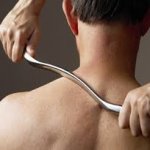Traditional massage that uses the hands of a therapist may be superior to IASTM techiques.
In a new study, different techniques were tested on subjects who demonstrated less than 30º dorsiflexion and a Silfverskoild test positive for soft-tissue restriction. One third of these subjects received hands-on treatment, one third received IASTM, and the other third did not receive any treatment.
The group did not receive any treatment improved standing dorsiflexion by 1.1º , while the IASTM improved by 1.8º . The group that received hands-on treatment, however, improved by 4.8º , which was statistically significant.
Surprisingly, kneeling dorsiflexion only improved by 4.4º after hands-on massage, while the subjects who had received IASTM improved by 3.1º , suggesting that the superiority of hands-on massage was much greater for standing than for kneeling dorsiflexion.
Conclusions
Many practitioners have spent thousands of dollars, if not tens of thousands of dollars, on courses and equipment in order to perform Graston or other IASTM techniques. Although there may be a time that these techniques are useful, this study suggests that in some cases, these protocols may sometimes be an inferior substitute to traditional hands-on treatment.
References
